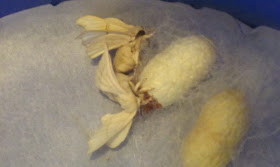About a week ago I decided that bubbles would be my theme for the Blairstown Farmers Market. I mean, bubbles are a clear winner on a lovely spring day at the market. How could I resist?
First things first: the bubble mix. You can buy some, sure. That's quick and easy, but a bit expensive, especially for large quantities. So I made my own using dish soap, water and bit of vegetable glycerin.
Recipes abound online, but I like about a 1:12 ratio of detergent to water with about a teaspoon or two of glycerin per cup of solution, depending on the detergent I've used. You can use corn syrup or sugar to make the bubbles last longer, but I find that makes the mix really sticky and attracts more insects, so I like glycerin instead. No matter what, your bubble mix will get better if you let it sit open overnight, especially if your detergent contains alcohol. That said, I usually don't have the patience to wait.
Great! You've got bubble mix! Now what? Get out the pipe cleaners! Let kids make bubble wands using the pipe cleaners. They'll often make all kinds of creative designs -- heart shaped tops and two-color sticks. After a bit, I like to ask if they get square bubbles form a square wands. Kids will laugh at me and say, "Of course not! You always get a round bubble!" That's when I like to ask, "Why?"
Make them think about it for a while.
See the Universe is an amazing thing, and it like to be efficient. A sphere allows the greatest volume to be trapped within the smallest surface area. So, you can trap the most air inside a round bubble, as opposed to a square, triangle or trapezoid using the same amount of bubble solution. A bubble wouldn't float long if it was bogged down by extra bubble mix!
The surface tension of the bubble mix pulls the bubble into that classic shape. The only way to get a bubble
to take another shape is to surround it by other bubbles. If you're looking for some wonderful geometrical studies,
calculating and modeling the volume to surface area ratios can be a lot of fun.
Now that you've got bubble mix, there are a lot of fun things you can do. For example, there are instructions for
giant bubbles and
bouncing bubbles. A friend at the market showed us how to create a bubble foamer, which was a huge hit. We just cut a plastic water bottle to separate the top "funnel" from the bottom. We attached a rag to the open end of the funnel with a rubber band. Dip the rag in bubble mix and blow through the drinking end of your water bottle. Tons of fun!
Now, let's move on to art! We did a really simple bubble print project that's easy to set up and really neat. In bowls, I mixed 2-3 tablespoons of washable, non-toxic tempera paint (bright colors work best -- blue, green, orange, red), 1 tablespoon of dish detergent and a 1/2 cup of water. Stir gently. Then, using a straw, blow bubbles in the mixture, letting them rise well above the bowl. Then gently lower a piece of paper onto the bubbles. As they pop they'll leave colorful bursts. You can keep adding bubble prints to fill your page, using many colors and experiment with how fast or slow you blow your bubbles (it can change the size of the bubbles).
You can also dip your bubble wand into the mixture and blow onto the paper to create fun patterns that way!
To finish up the day, we made some bubbles in other ways. We combined vinegar and baking soda, a classic chemistry experiment that yields lots of bubbles as carbon dioxide is released. But the real hit was Mentos in diet cola, a la Steve Spangler and Mythbusters The set up is easy: Open a 2-liter bottle of inexpensive diet cola; unwrap a 6-pack of classic Mentos; use index cards to create a tube to hold the Mentos and a slip to cover the top of the bottle; place the slip over the bottle top, the tube on the slip and add the Mentos. When you're ready, pull the slip out and let the Mentos drop into the cola. Then get out of the way quickly!

The result to pretty awesome. Why it works is somewhat up to debate. The links above will review some of the best ideas put forth in detail. Basically the idea is that the dissolving candy breaks the surface tension of the soda, which is holding back the expansion of the carbon dioxide bubbles within. The pits all over the candy then provide nucleation sites for bubbles to attach. The heavy candies fall to the bottom of the bottle, forcing the bubbles -- and the soda -- to come gushing out of that small opening, forming a geyser! You can vary the reaction in many ways to create a super fun (and potentially messy) experiment.























